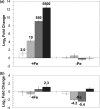The elemental sulfur-responsive protein (SipA) from the hyperthermophilic archaeon Pyrococcus furiosus is regulated by sulfide in an iron-dependent manner
- PMID: 20802041
- PMCID: PMC2953673
- DOI: 10.1128/JB.00660-10
The elemental sulfur-responsive protein (SipA) from the hyperthermophilic archaeon Pyrococcus furiosus is regulated by sulfide in an iron-dependent manner
Abstract
The gene (sipA) encoding the sulfur-induced protein A (PF2025) is highly upregulated during growth of Pyrococcus furiosus on elemental sulfur (S(0)). Expression of sipA is regulated by sulfide, the product of S(0) reduction, but in an iron-dependent manner. SipA is proposed to play a role in intracellular iron sulfide detoxification.
Figures


Similar articles
-
Deletion strains reveal metabolic roles for key elemental sulfur-responsive proteins in Pyrococcus furiosus.J Bacteriol. 2011 Dec;193(23):6498-504. doi: 10.1128/JB.05445-11. Epub 2011 Sep 30. J Bacteriol. 2011. PMID: 21965560 Free PMC article.
-
DNA microarray analysis of the hyperthermophilic archaeon Pyrococcus furiosus: evidence for anNew type of sulfur-reducing enzyme complex.J Bacteriol. 2001 Dec;183(24):7027-36. doi: 10.1128/JB.183.24.7027-7036.2001. J Bacteriol. 2001. PMID: 11717259 Free PMC article.
-
Insights into the metabolism of elemental sulfur by the hyperthermophilic archaeon Pyrococcus furiosus: characterization of a coenzyme A- dependent NAD(P)H sulfur oxidoreductase.J Bacteriol. 2007 Jun;189(12):4431-41. doi: 10.1128/JB.00031-07. Epub 2007 Apr 20. J Bacteriol. 2007. PMID: 17449625 Free PMC article.
-
The role of TrmB and TrmB-like transcriptional regulators for sugar transport and metabolism in the hyperthermophilic archaeon Pyrococcus furiosus.Arch Microbiol. 2008 Sep;190(3):247-56. doi: 10.1007/s00203-008-0378-2. Epub 2008 May 11. Arch Microbiol. 2008. PMID: 18470695 Review.
-
The Development of Tungsten Biochemistry-A Personal Recollection.Molecules. 2023 May 11;28(10):4017. doi: 10.3390/molecules28104017. Molecules. 2023. PMID: 37241758 Free PMC article. Review.
Cited by
-
Deletion strains reveal metabolic roles for key elemental sulfur-responsive proteins in Pyrococcus furiosus.J Bacteriol. 2011 Dec;193(23):6498-504. doi: 10.1128/JB.05445-11. Epub 2011 Sep 30. J Bacteriol. 2011. PMID: 21965560 Free PMC article.
-
Regulation of iron metabolism by Pyrococcus furiosus.J Bacteriol. 2013 May;195(10):2400-7. doi: 10.1128/JB.02280-12. Epub 2013 Mar 15. J Bacteriol. 2013. PMID: 23504018 Free PMC article.
-
Biological iron-sulfur storage in a thioferrate-protein nanoparticle.Nat Commun. 2017 Jul 20;8:16110. doi: 10.1038/ncomms16110. Nat Commun. 2017. PMID: 28726794 Free PMC article.
-
Deletion of alternative pathways for reductant recycling in Thermococcus kodakarensis increases hydrogen production.Mol Microbiol. 2011 Aug;81(4):897-911. doi: 10.1111/j.1365-2958.2011.07734.x. Epub 2011 Jul 13. Mol Microbiol. 2011. PMID: 21749486 Free PMC article.
-
Metabolic Adaptation to Sulfur of Hyperthermophilic Palaeococcus pacificus DY20341T from Deep-Sea Hydrothermal Sediments.Int J Mol Sci. 2020 Jan 6;21(1):368. doi: 10.3390/ijms21010368. Int J Mol Sci. 2020. PMID: 31935923 Free PMC article.
References
-
- Adams, M. W. W., J. F. Holden, A. L. Menon, G. J. Schut, A. M. Grunden, C. Hou, A. M. Hutchins, F. E. Jenney, Jr., C. Kim, K. Ma, G. Pan, R. Roy, R. Sapra, S. V. Story, and M. F. J. M. Verhagen. 2001. Key role for sulfur in peptide metabolism and in regulation of three hydrogenases in the hyperthermophilic archaeon Pyrococcus furiosus. J. Bacteriol. 183:716-724. - PMC - PubMed
-
- Amend, J. P., and E. L. Shock. 2001. Energetics of overall metabolic reactions of thermophilic and hyperthermophilic archaea and bacteria. FEMS Microbiol. Rev. 25:175-243. - PubMed
-
- Birkett, C. R., K. E. Foster, L. Johnson, and K. Gull. 1985. Use of monoclonal antibodies to analyse the expression of a multi-tubulin family. FEBS Lett. 187:211-218. - PubMed
-
- Fiala, G., and K. O. Stetter. 1986. Pyrococcus furiosus sp. nov. represents a novel genus of marine heterotrophic archaebacteria growing optimally at 100° C. Arch. Microbiol. 145:56-61.
-
- Hatton, B., and D. Rickard. 2008. Nucleic acids bind to nanoparticulate iron (II) monosulphide in aqueous solutions. Orig. Life Evol. Biosph. 38:257-270. - PubMed
Publication types
MeSH terms
Substances
LinkOut - more resources
Full Text Sources
Medical

